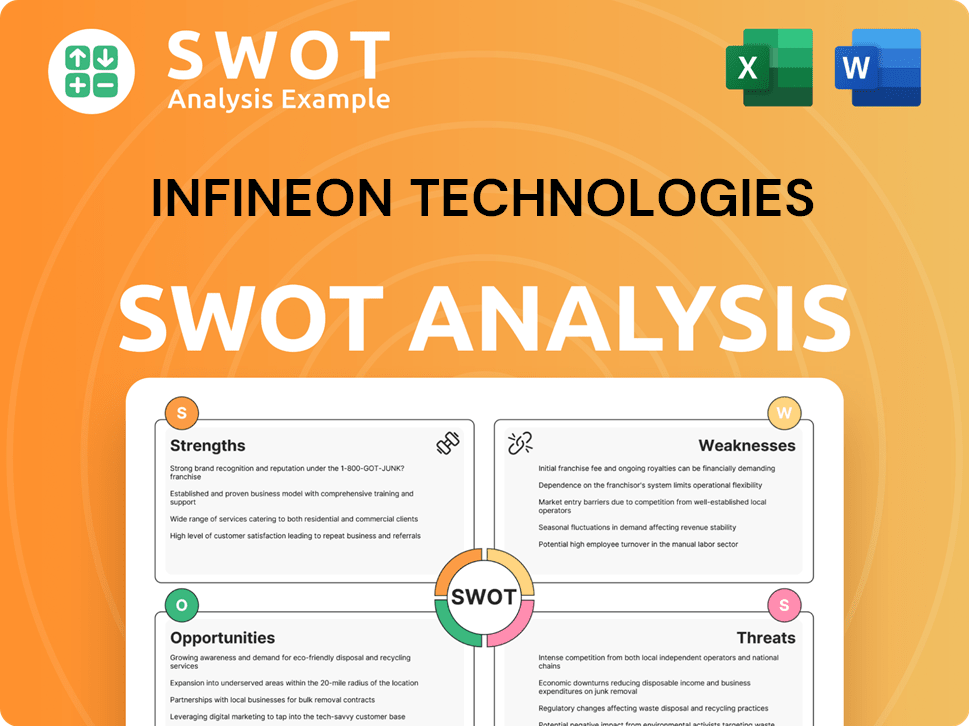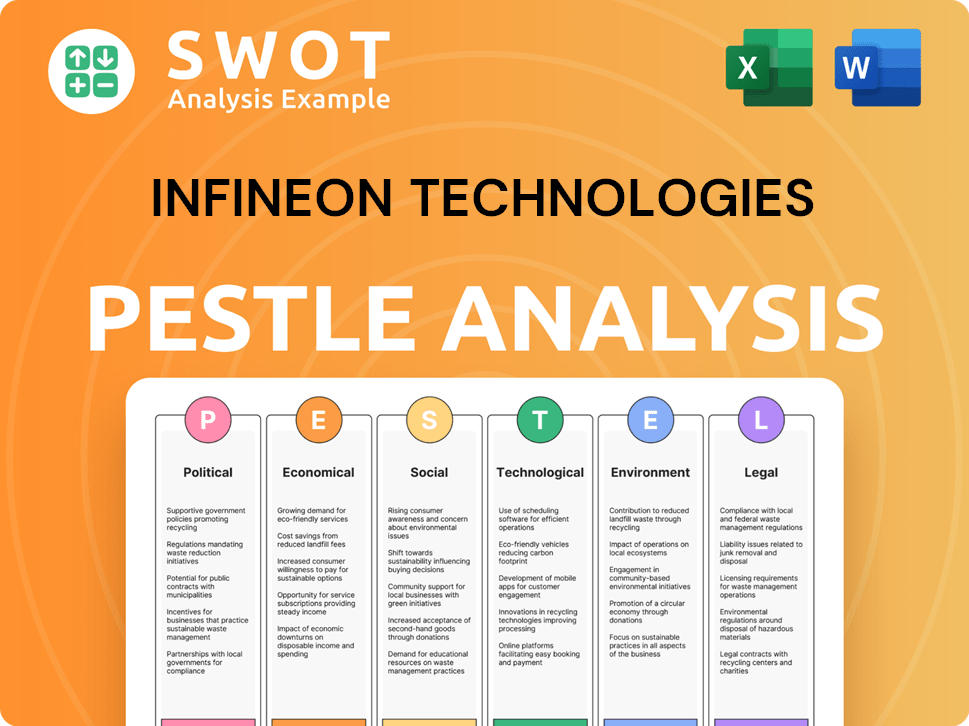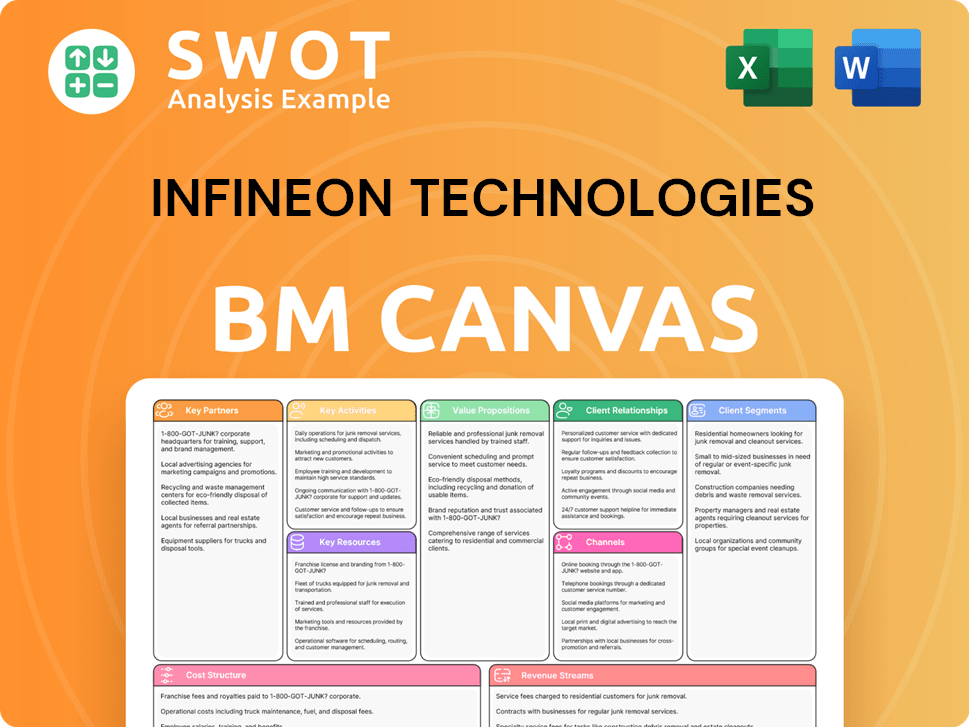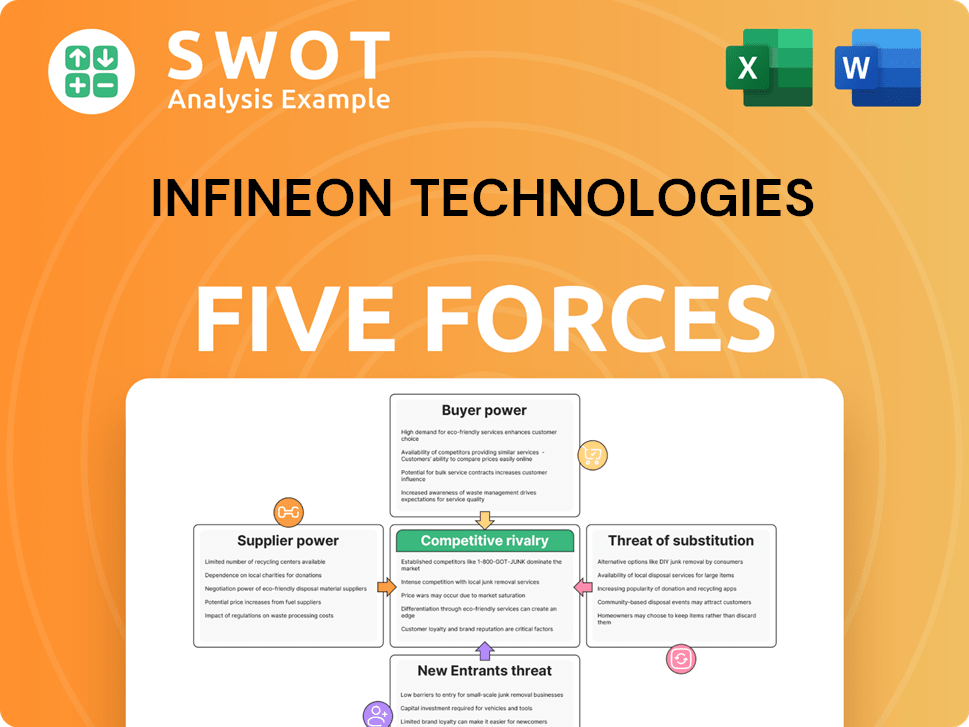Infineon Technologies Bundle
Who Really Controls Infineon Technologies?
Ever wondered who steers the ship at one of the world's leading semiconductor giants? Understanding the Infineon Technologies SWOT Analysis is just the beginning. Unraveling the intricate web of Infineon ownership is key to understanding its strategic moves and future trajectory. From its roots as a Siemens spin-off to its current status, Infineon's ownership story is a fascinating tale of evolution and influence.

This exploration into Who owns Infineon is more than just a corporate snapshot; it's a deep dive into the forces shaping the future of technology. We'll examine the major Infineon shareholders, the impact of its Infineon stock performance, and the evolution of its ownership structure since its separation from its Infineon parent company. Discover the key players and their influence on a company at the forefront of innovation, including insights into questions like "Who is the CEO of Infineon Technologies?" and "Is Infineon a publicly traded company?"
Who Founded Infineon Technologies?
The story of Infineon Technologies differs from typical startup stories. Instead of individual founders, it emerged from a corporate restructuring. In 1999, Siemens AG spun off its semiconductor business, previously known as Siemens Semiconductors, to create Infineon Technologies AG.
This spin-off meant that the initial 'founding ownership' was Siemens AG itself. Siemens then divested its shares through an initial public offering (IPO). There were no individual founders with specific equity splits at the company's inception. The company was carved out from a larger conglomerate.
Early ownership was primarily held by Siemens AG. This later transitioned to a broader public shareholder base through the IPO in March 2000. Siemens aimed to unlock value and give the semiconductor business more focus. The IPO offered shares to institutional and retail investors. This shifted ownership from a single corporate parent to a dispersed shareholder base.
Infineon Technologies was created through a spin-off from Siemens AG.
Siemens AG initially owned Infineon.
The IPO broadened the shareholder base, moving away from a single corporate owner.
There were no early backers or angel investors in the typical startup sense.
The initial management team steered the newly independent company.
The founding team's vision was reflected in the strategic direction of the public entity.
Understanding the Infineon Technologies company profile reveals that the company's ownership structure evolved from a corporate spin-off. The initial ownership rested with Siemens AG, followed by a transition to public shareholders. This model differs from companies founded by individual entrepreneurs. As of the latest financial reports, Infineon continues to be a publicly traded company, with its shares held by a diverse group of institutional and retail investors. Knowing who owns Infineon is key to understanding its strategic direction and financial performance. As of the fiscal year 2024, Infineon reported revenues of approximately €16.3 billion, highlighting its significant market presence.
- Infineon's ownership structure transitioned from Siemens AG to public shareholders.
- The IPO in March 2000 marked a significant shift in ownership.
- There were no traditional founders or early-stage investors.
- Infineon is a publicly traded company.
Infineon Technologies SWOT Analysis
- Complete SWOT Breakdown
- Fully Customizable
- Editable in Excel & Word
- Professional Formatting
- Investor-Ready Format

How Has Infineon Technologies’s Ownership Changed Over Time?
The ownership structure of Infineon Technologies has undergone significant changes since its inception. Initially a subsidiary of Siemens AG, the company transitioned to a publicly traded entity through an initial public offering (IPO) on March 13, 2000. This IPO, listed on both the Frankfurt Stock Exchange and the New York Stock Exchange, marked a pivotal moment, broadening the shareholder base and setting the stage for future ownership evolution. The transition from a wholly-owned subsidiary to a publicly traded company was a strategic move to enhance its growth potential and market presence.
Following the IPO, Infineon's ownership shifted, with institutional investors becoming the dominant shareholders. This transformation reflects a broader trend in the technology sector, where large institutional investors play a crucial role. The shift also reflects the company's strategic direction and market performance, influencing investor confidence and shareholding patterns. The evolution of Infineon's ownership structure is a dynamic process, influenced by market trends, strategic initiatives, and investor sentiment.
| Key Event | Date | Impact on Ownership |
|---|---|---|
| IPO | March 13, 2000 | Transition from Siemens AG subsidiary to publicly traded company; broad shareholder base established. |
| Subsequent Market Activity | Ongoing | Fluctuations in share prices and trading volumes; institutional investors increase holdings. |
| Strategic Partnerships and Investments | Ongoing | May influence ownership through share offerings or acquisitions. |
As of early 2025, the major stakeholders in Infineon Technologies are primarily institutional investors. These include asset managers like BlackRock, The Vanguard Group, and Capital Group. Reports from late 2024 and early 2025 indicate that institutional ownership often exceeds 70-80% of total outstanding shares. The executive and supervisory board members hold a relatively small percentage of shares, aligning their interests with company performance. For more insights, you can explore the Growth Strategy of Infineon Technologies.
Understanding Infineon ownership is crucial for investors and stakeholders. The majority of Infineon shares are held by institutional investors, reflecting a stable and diverse shareholder base.
- Institutional investors hold a significant portion of Infineon stock.
- Executive and supervisory board members hold a smaller percentage.
- Changes in ownership reflect market trends and investor confidence.
- Infineon's focus on electromobility and renewable energy solutions attracts ESG-focused funds.
Infineon Technologies PESTLE Analysis
- Covers All 6 PESTLE Categories
- No Research Needed – Save Hours of Work
- Built by Experts, Trusted by Consultants
- Instant Download, Ready to Use
- 100% Editable, Fully Customizable

Who Sits on Infineon Technologies’s Board?
The Board of Directors at Infineon Technologies AG, a pivotal aspect of Infineon ownership, operates under a two-tier board structure typical of German stock corporations. This structure includes a Management Board (Vorstand) responsible for daily operations and a Supervisory Board (Aufsichtsrat) that oversees the Management Board. The Supervisory Board is composed of members representing both shareholder and employee interests, as mandated by German co-determination laws.
The Supervisory Board usually consists of 16 members. Half of these members are elected by shareholders during the Annual General Meeting, while the other half is elected by employees. This structure helps ensure that the board's decisions reflect the interests of all stakeholders. The voting structure is straightforward: one share equals one vote. This structure ensures proportional voting power based on ownership, and there are no known special voting rights that would grant outsized control to any individual or entity. For more insights into the company's strategic direction, consider reading about the Growth Strategy of Infineon Technologies.
| Board Member | Role | Notes |
|---|---|---|
| Dr. Wolfgang Eder | Chairman of the Supervisory Board | Oversees the Supervisory Board's activities. |
| Jochen Hanebeck | CEO | Leads the Management Board. |
| Sven Schneider | CFO | Manages the company's finances. |
Understanding the board structure is crucial for anyone interested in Infineon stock and the company's governance. The composition of the board, with its balance of shareholder and employee representation, reflects a commitment to inclusive decision-making. The one-share-one-vote system further ensures that Infineon shareholders have voting power proportional to their ownership, contributing to a transparent and equitable governance model. This structure supports strategic alignment with market trends and technological advancements, guided by the collective expertise of the boards.
Infineon's governance structure is designed to balance various stakeholder interests, ensuring both operational efficiency and strategic oversight.
- The Supervisory Board oversees the Management Board.
- The board includes both shareholder and employee representatives.
- Voting rights are proportional to share ownership.
- The governance structure promotes transparency and fairness.
Infineon Technologies Business Model Canvas
- Complete 9-Block Business Model Canvas
- Effortlessly Communicate Your Business Strategy
- Investor-Ready BMC Format
- 100% Editable and Customizable
- Clear and Structured Layout

What Recent Changes Have Shaped Infineon Technologies’s Ownership Landscape?
Over the past few years (2022-2025), the ownership landscape of Infineon Technologies has been shaped by several key developments. The acquisition of Cypress Semiconductor in 2020 significantly expanded Infineon's presence, particularly in the automotive and IoT markets. This strategic move, however, primarily influenced the company through share issuance or debt rather than a direct alteration of major shareholders. The company's focus on growth and strategic partnerships continues to be a central theme, with no public announcements regarding privatization or substantial ownership changes.
Industry trends, such as the rise of institutional ownership and the emphasis on ESG (Environmental, Social, and Governance) investing, have played a role in shaping Infineon's shareholder base. Institutional investors are increasingly allocating capital to companies with strong sustainability profiles, which benefits Infineon due to its focus on energy efficiency and sustainable technologies. Routine governance adjustments, like changes in board members or executive leadership, reflect strategic adaptations rather than fundamental shifts in ownership control. Infineon's strong performance in key markets is likely to continue attracting institutional investment, further solidifying its current ownership trends.
| Metric | Value (as of Q1 2024) | Source |
|---|---|---|
| Market Capitalization | Approximately €68 billion | Refinitiv |
| Institutional Ownership | Around 65% | Company Filings |
| Revenue (FY2023) | €16.3 billion | Infineon Annual Report |
The evolution of Infineon Technologies ownership reflects broader trends in the semiconductor industry. For insights into the company's origins, consider reading Brief History of Infineon Technologies. The company's focus remains on organic growth and strategic partnerships, with institutional investors continuing to play a significant role in its shareholder base. The company's financial performance and strategic direction are key factors influencing its ownership structure.
Strategic acquisitions, like Cypress Semiconductor, have expanded Infineon's market presence. The company focuses on organic growth and partnerships, with no privatization plans.
Increased institutional ownership and ESG investing influence the shareholder base. Leadership changes are routine governance adjustments.
Strong performance in electric vehicles and renewable energy attracts investment. Market capitalization is approximately €68 billion (Q1 2024).
Infineon's financial success and strategic direction are key ownership factors. Institutional investors are expected to maintain a significant role.
Infineon Technologies Porter's Five Forces Analysis
- Covers All 5 Competitive Forces in Detail
- Structured for Consultants, Students, and Founders
- 100% Editable in Microsoft Word & Excel
- Instant Digital Download – Use Immediately
- Compatible with Mac & PC – Fully Unlocked

Related Blogs
- What are Mission Vision & Core Values of Infineon Technologies Company?
- What is Competitive Landscape of Infineon Technologies Company?
- What is Growth Strategy and Future Prospects of Infineon Technologies Company?
- How Does Infineon Technologies Company Work?
- What is Sales and Marketing Strategy of Infineon Technologies Company?
- What is Brief History of Infineon Technologies Company?
- What is Customer Demographics and Target Market of Infineon Technologies Company?
Disclaimer
All information, articles, and product details provided on this website are for general informational and educational purposes only. We do not claim any ownership over, nor do we intend to infringe upon, any trademarks, copyrights, logos, brand names, or other intellectual property mentioned or depicted on this site. Such intellectual property remains the property of its respective owners, and any references here are made solely for identification or informational purposes, without implying any affiliation, endorsement, or partnership.
We make no representations or warranties, express or implied, regarding the accuracy, completeness, or suitability of any content or products presented. Nothing on this website should be construed as legal, tax, investment, financial, medical, or other professional advice. In addition, no part of this site—including articles or product references—constitutes a solicitation, recommendation, endorsement, advertisement, or offer to buy or sell any securities, franchises, or other financial instruments, particularly in jurisdictions where such activity would be unlawful.
All content is of a general nature and may not address the specific circumstances of any individual or entity. It is not a substitute for professional advice or services. Any actions you take based on the information provided here are strictly at your own risk. You accept full responsibility for any decisions or outcomes arising from your use of this website and agree to release us from any liability in connection with your use of, or reliance upon, the content or products found herein.